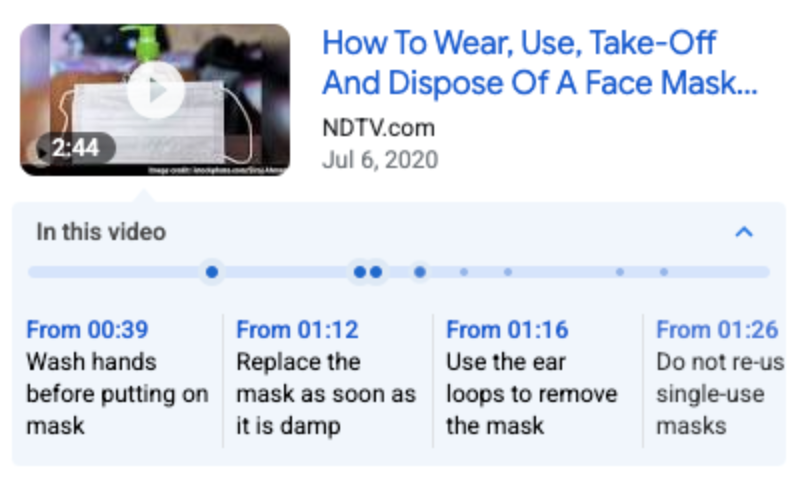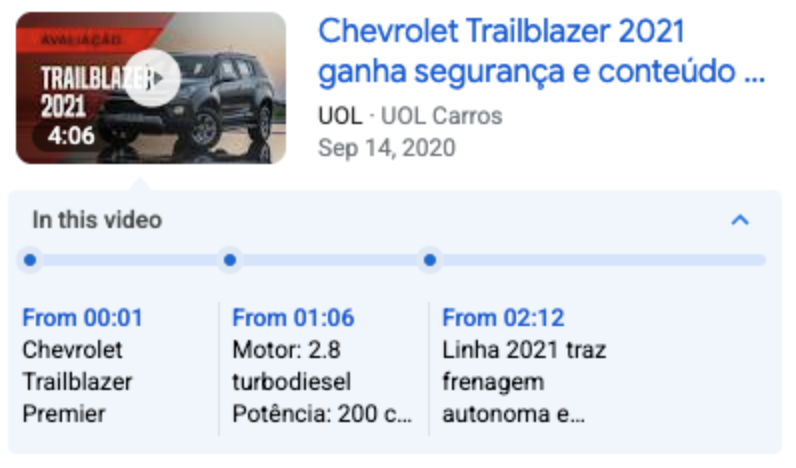วันจันทร์ที่ 19 กรกฎาคม 2021
หลังจากที่ได้เปิดตัวช่วงสำคัญของวิดีโอเป็นครั้งแรกในปี 2019 เราก็ได้ขยายและปรับปรุงฟีเจอร์อย่างต่อเนื่อง โดยเราได้แก้ไขดีไซน์ให้ดีขึ้น และทำให้ช่วงสำคัญพร้อมใช้งานสำหรับวิดีโอจำนวนมากขึ้น รวมถึงในอุปกรณ์เคลื่อนที่และเดสก์ท็อปในทุกภูมิภาคที่ใช้ Google Search ได้ ช่วงสำคัญช่วยให้ผู้คนไปยังส่วนที่เกี่ยวข้องที่สุดในวิดีโอได้ทันทีและไปยังช่วงที่ต้องการได้เหมือนอ่านบทต่างๆ ในหนังสือ
วันนี้เราเปิดตัววิธีใหม่ในการเปิดใช้ช่วงสำคัญของวิดีโอในเว็บไซต์ของคุณ โดยที่คุณไม่ต้องติดป้ายกำกับแต่ละช่วงด้วยตนเอง สิ่งที่คุณต้องทำก็เพียงบอกให้ Google ทราบถึงรูปแบบ URL สำหรับการข้ามไปยังการประทับเวลาที่เฉพาะเจาะจงภายในวิดีโอของคุณ จากนั้น Google จะใช้ AI เพื่อระบุช่วงสำคัญในวิดีโอ และแสดงลิงก์ดังกล่าวไปยังช่วงเหล่านั้นในผลการค้นหาโดยตรง


เราประกาศการทดสอบ SeekToAction รุ่นเบต้าเป็นครั้งแรกใน Google I/O และในวันนี้เราได้เสร็จสิ้นการทดสอบเบต้าสำหรับฟีเจอร์นี้และรองรับมาร์กอัปนี้สำหรับทุกเว็บไซต์ที่มีวิดีโอแล้ว ต่อไปนี้คือเคล็ดลับที่ควรทราบเมื่อใช้มาร์กอัปนี้
- URL ต้องทำ Deep Link ไปยังตำแหน่งจุดอื่นได้ ไม่ใช่ไปได้แค่จุดเริ่มต้นของวิดีโอ ตัวอย่างเช่น
https://www.example.com/example?t=30เริ่มต้นที่ตำแหน่งวินาทีที่ 30 ในวิดีโอ - ใช้มาร์กอัป
SeekToActionในหน้าวิดีโอทุกหน้าที่คุณต้องการให้ Google ระบุช่วงสำคัญโดยอัตโนมัติและทำตามหลักเกณฑ์เพิ่มเติมของเรา ลองดูตัวอย่างโดยละเอียดด้านล่างนี้ - หากต้องการระบุช่วงสำคัญในวิดีโอโดยอัตโนมัติ Google จะต้องดึงไฟล์เนื้อหาวิดีโอได้
โปรดทราบว่ามาร์กอัป SeekToAction ใช้ได้กับวิดีโอที่ฝังในเว็บไซต์ของคุณเองเท่านั้น หากโพสต์วิดีโอบนแพลตฟอร์มของบุคคลที่สามที่คุณไม่ได้ควบคุมมาร์กอัป schema.org ให้ติดต่อแพลตฟอร์มเหล่านั้นเพื่อดูว่ามาร์กอัปนี้ได้รับการรองรับหรือไม่
เราหวังว่ามาร์กอัป SeekToAction จะเป็นวิธีเปิดใช้ช่วงสำคัญที่ง่ายและมีประสิทธิภาพและช่วยให้ผู้คนมีส่วนร่วมกับวิดีโอของคุณมากขึ้น หากมีข้อสงสัย โปรดโพสต์คําถามในฟอรัม คุยกับ @googlesearchc ใน Twitter หรือส่งความคิดเห็นหาเราโดยตรงในหน้าเอกสารประกอบ
